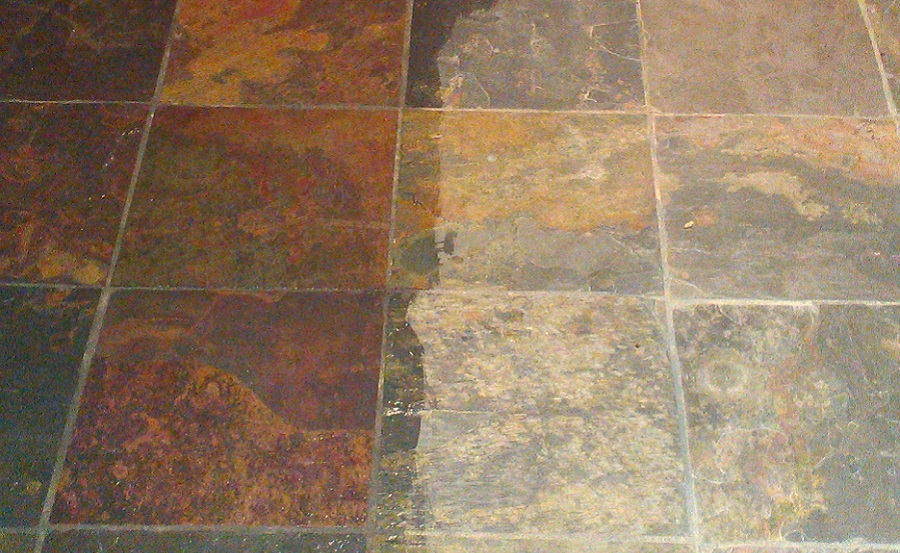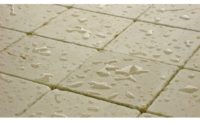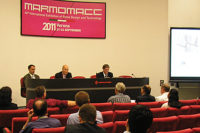The primary function of a stone sealer is to provide stain resistance to a porous stone. To best understand the realistic expectations of stone sealers, the operative word "resistance" should be viewed in terms of "reaction time." There are many sealers available today, yet none make the claim of being "stain proof." What sealers will provide is "time to react," meaning a period of time that the sealer will hold out the contaminant, allowing easy removal from the stone surface before there is stain penetration. Based on the quality of the sealer used and the type of contaminants the stone is exposed to, reaction time will range from mere moments to many hours. The primary distinction between today's penetrating (impregnator-type) sealers is the reaction time they provide and the range of contaminants they resist.
Stone sealers are either water-based or solvent-based. The base or carrier, in itself, is not an important criteria - as the water or solvent functions only as a carrier, mobilizing the sealer components into the stone. Both carriers are short lived after carrying the sealer into the stone. The water undergoes natural evaporation, while the solvent flashes off quickly. Since solvent-based sealers have been around a lot longer than water-based sealers, there are those who feel the solvent-based technology must be superior. The truth of the matter is that although there are subtle differences relating to application techniques and curing times, performance levels can be comparable.Aside from being either water-based or solvent-based, sealers are also differentiated by where they are positioned "in" or "on" the stone. Penetrating (impregnator) sealers are designed to be absorbed "in" (below) the stone surface. They are not designed as surface coatings and do not provide a shine or gloss. Surface or coating-type sealers, on the other hand are designed to bond "on" the stone surface and normally provide anywhere from a low to a high level of surface sheen. Coating sealers are usually never recommended on polished or even very dense, smooth surfaced stone such as marble, granite and limestone. The reason is that for a coating-type sealer to perform, it requires either a very porous surface or a textured surface where the coating-type sealer can achieve a mechanical bond. On dense, smooth surfaces only penetrating-type sealers are recommended, as they do not need to bond to the stone surface but require only slight stone porosity for penetration.
Regardless of whether water-based or solvent-based, penetrating-type or coating-type sealers are considered, here are some important attributes that a sealer must exhibit to ensure performance and longevity:
- Stain Resistance: This is the primary reason for sealing. Choose a sealer that offers protection against the contaminants common to the area of the stone installation. For example, in kitchens or food serving areas, use a sealer that provides excellent oil resistance.
- Breathability: This is an often overlooked, but very important, quality that a sealer must possess. It is understood and accepted that natural stone must be allowed to breathe (allow moisture-vapor transmission). Stone sealers that inhibit moisture-vapor transmission can cause eventual deterioration of the stone in addition to discoloration or spalling of the sealer. Breathable sealers are designed on the principal of allowing vapor to pass (breathe) through as a gas, but to repel liquids. Unlike the sealers of yesterday, where a 30-day cure time after stone installation was required prior to sealing, many of today's sealers breathe sufficiently to be used as soon as 48 hours after stone installation. This takes into account that during installation, moisture remaining within the stone will not be entrapped, but will migrate through the sealer as a vapor.
- Chemical Resistance: With the myriad of cleaners and various chemicals used on and around a stone installation today, a sealer must be highly resistant to chemicals ranging from acids to alkaline cleaners. Without strong chemical resistance, sealers would not be able to claim long life and would require frequent reapplication.
- Health and Environmental considerations: Certain job sites, especially commercial sites such as schools, hospitals, and workplaces, may require water-based sealers to avoid the increased safety precautions that can be associated with solvent-based sealers that are required during the sealing process. In addition to increased safety requirements, many solvent-based sealers have strong odors that may linger until the solvent dissipates, and some solvent-based sealers contain "VOCs" (Volitale Organic Compounds) that are defined as being ozone-depleting or detrimental to our environment. Most water-based sealers have no or low odor, have no or very low VOC's and are environmentally safe. Regardless of the sealer selected, always read directions carefully, paying close attention to any label precautions listed.
- Freeze-Thaw Stability: Not only is it important for a sealer to remain freeze-thaw stable in the bottle, but the ultimate sealer remaining in or on the stone must have the ability to exhibit resilience to freeze-thaw cycles. Subjected to freeze-thaw conditions, a stone installation must be capable of expanding and contracting. The sealer used must also be capable of expanding and contracting, or it will be compromised and quickly lose sealing capabilities.
- Slip Resistance: A sealer, whether it is a penetrating or coating-type, should not adversely affect the stone's slip resistance. If used per the directions, penetrating-type sealers are designed to penetrate the stone substrate, with any remaining sealer residue wiped off the stone surface. The net result should be no change to the surface coefficient of friction. In cases where penetrating sealer residue is allowed to remain, a temporary improvement in slip resistance may be achieved, but will normally be eradicated after initial traffic exposure or routine cleanings. Sealed stone surfaces should be properly maintained to reduce chances of slip-fall accidents.
- UV Resistance: Sealers, whether they are penetrating or coating-type, should be resistant to ultra-violet light, and not yellow or deteriorate due to UV exposure.
- Easy Reapplication: Once a sealer has been used successfully, it is a good idea to stay with the same sealer when eventual reapplication is needed (usually due to surface wear on a surface-type sealer and loss of stain resistance on a penetrating-type sealer). Stripping or removing an existing sealer is often difficult and arduous, so sealers should be selected that can be reapplied without the requirement of stripping the existing sealer prior to reapplication.
- Desired Look: You can use numerous applications of a penetrating-type sealer and never achieve a surface shine. Some penetrating-type sealers may slightly darken or lighten the natural stone. Coating type sealers usually highlight the stone surface, thus bringing out the real color and nuances in the stone not always visible before sealing. If the primary requirement is to darken or color enhance a tumbled or faded stone, then a color-enhancer sealer should be considered. There are several stone enhancer-sealers available today that enhance and seal, not requiring a separate sealer application. Regardless of the product selected, always test a small area to determine if the desired appearance is achieved.
Sealers properly selected and used can be extremely beneficial in the protection, ongoing maintenance and longevity of a stone installation. Haphazard choice and application, on the other hand, can result in poor performance, increased maintenance and frequent re-application requirements. Over the years, there has been a lot of accurate as well as a lot of inaccurate information disseminated about sealers. Some of the most commonly heard comments include:
"The better the sealer beads water, the better it will resist staining." This is not accurate. The water beading attributed to a sealer is based on the surface tension created by the sealer residue. The first time that the sealed stone surface is cleaned, the surface tension is relaxed, resulting in the water no longer holding a strong bead on the surface. Remember, it is stain resistance that is the desired result, not temporary water beading. Relaxed surface tension does not relate to a reduction in stain resistance.
"Water-based sealers cannot be used for exterior applications." This is false. Remember, the water and solvent are only carriers that evaporate, leaving the sealer in place. It is that sealer that remains in or on the stone that must be compatible with an exterior environment. Many water-based, penetrating-type sealers are designed for use in exterior environments. However, coating-type sealers, whether they be water-based or solvent-based, should be evaluated with more caution for exposed exterior environments. For sealers to perform well in exterior areas, they must possess attributes such as "freeze-thaw stability," "breathability," "slip-resistance" and "UV stability." Although there are some coating sealers that meet these requirements for exterior performance, most are designed strictly for interior application.
"Sealers are not designed to be waterproof." Remember, sealers must allow moisture vapor transmission, and it must be noted that they are not designed to hold a hydrostatic head (holding back water pressure). If waterproofing is the desired outcome, a waterproofing membrane or agent should be considered.
"Solvent-based sealers penetrate better than water-based sealers." While it is true that solvent molecules are smaller than water molecules, additional clarification is warranted. A solvent-based sealer may penetrate deeper contingent on weather conditions. In warm weather, the solvent carrier may dissipate so quickly into the atmosphere that the sealer will not gain much depth into the stone before the solvent escapes. Water will penetrate even dense surfaces such as polished granite, but will not generally penetrate as deeply or as quickly as a solvent-based sealer. When used properly, under proper conditions, both water- and solvent-based sealers gain adequate penetration into natural stone surfaces. It is also important to note that after penetrating, the sealer must be positioned close to the surface to provide best stain resistance from surface contaminants. The important result is not how deep the sealer penetrates into the stone, but how close the sealer positions itself to the surface where it can guard against stain penetration.
"Unlike solvent-based sealers, water-based sealers cannot be cross-linked to give best performance." This is not true. Water-based sealer technology has improved dramatically in recent years. There are several water-based sealers available utilizing cross-linked polymers which provide worthy alternatives to solvent-based sealers.
In conclusion, sealer technology and resultant products have come a long way over the years when sealers performed poorly against contaminants (especially oils), and had an effective life span of less than a year before requiring stripping and reapplication. Whether your preference is towards a water- or solvent-based alternative, there are several brands of quality options available in today's market-place. Sealer pricing ranges from very inexpensive to very expensive, with the pricing usually having a direct correlation to performance and longevity. Don't be afraid to contact the manufacturer directly with any technical question. Remember, they want you to be satisfied with the "sealer-use experience." With all of the options available, it is wise to choose a manufacturer that offers a full range of stone care products to help assure compatibility and longevity of a stone installation.


